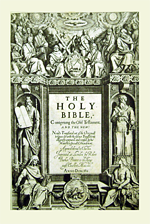Januray 22, 2011

|
Gathering together much of the source material that the original Cambridge translators used to begin their masterwork in the early seventeenth century, the exhibition includes William Tyndale’s first pocket-sized smuggled editions of his own translations, Henry VIII’s enormous Great Bible, a first edition of the Geneva or ‘Breeches’ Bible and also a very rare copy of the notorious ‘Wicked Bible’ of 1631 – featuring the misprint ‘Thou shalt commit adultery’.
One of the University’s greatest treasures, the Gutenberg Bible of 1455 – the first printed Bible of all – will also be on display, alongside two fourth-century leaves of St John’s Gospel in Coptic, and an 11th-century psalter in Latin and Old English.
The University Library has been able to draw material for the exhibition from the Bible Society’s unique library and archives, held in Cambridge since 1985, as well as from its own pre-eminent collections.
For more details see: http://www.lib.cam.ac.uk/exhibitions/KJV/index.html
Author and journalist Adam Nicolson, who launched the exhibition at a reception on 17 January, said: “The King James Bible is the most influential book in the English language. For almost 300 of its 400 years (c.1660-c.1950) it was the core of English consciousness and the touchstone of the culture.
“For those years it became the great national text, a national shrine, the one umbrella under which the whole country could gather. It was, in that way, our greatest cathedral, but a cathedral made only of words.
“For all sorts of reasons it has, at least until this year, faded from view. The 20th century largely abandoned it, just as most people stopped going to church and so stopped hearing its marvellous music. That is why it is worth having an exhibition like this: it is a reminder of roots, of one of the great compositions of our culture. To abandon it would be simply to impoverish ourselves.”
Cambridge University Library’s Emily Dourish, who co-ordinated the exhibition, said: “the display not only traces the history of the English Bible translation which culminated in the King James Version, but also looks at its reception and use by its earliest readers.”
The King James Bible did not spring directly from the minds of its translators in the reign of James I. Its text is to a large extent a patchwork of the many versions produced, around half outside England, in the preceding century. It was drawn together and harmonised by a painstaking process of comparison and revision by divinity scholars at Cambridge, Oxford and Westminster.
Nor was it universally popular; Puritans disliked it, scholars took delight in pointing out its errors, and the public had a prior loyalty to the Geneva version of fifty years earlier.
Added Nicolson: “The point about the translation is that it gathered all the best from the translations of the 16th century and winnowed them, sifting out what was good, coining new phrases where these were better, applying the best of Hebrew and Greek scholarship to the task, attempting the impossible fusion of utter fidelity to the original, utter clarity and the richest of verbal music.
“The virtue of an exhibition like this is that it allows you to see the communal making of a great book at work. The 1611 translators were aiming to perfect something that had been going on for 80 years, ever since Tyndale began to translate the New Testament into English (following Luther's model) in the 1520s. Gathered in this exhibition are all the ingredients which the Translators gathered themselves.
“This is the rich pool from which the King James Bible drank and then emerged fully formed in 1611, written not really by the Jacobean translators themselves but by the century of Englishmen who had come before them.
“The King James Bible is the most marvellous
polishing job in the history of English. And nothing I
have ever seen brings that home more clearly than this
exhibition.”
Great and Manifold Blessings: The Making of the King James
Bible runs from January 18-June 18, 2011 (closed April
22-25 inclusive). Admission free, Monday-Friday 9am-6pm,
Saturday 9am-4.30pm. Sunday closed.
